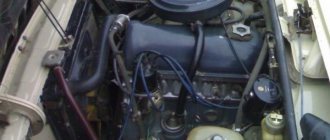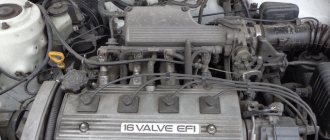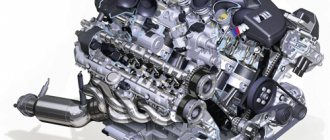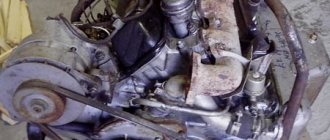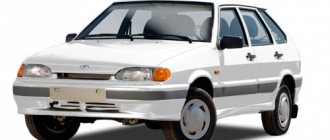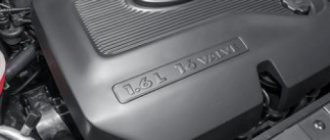The VAZ 2106 engine is used in small class passenger cars.
It has been produced by the Volzhsky Automobile Plant since 1976. The VAZ 2106 engine cools the system in a closed container using a specially designed liquid. It is located at the very top of the camshaft.
This engine is considered a four-stroke, has a carburetor system and an in-line engine. The liquid inside the motor has forced circulation to quickly cool the container.
The engine has a combined lubrication system. That is, this process occurs under a certain pressure and in the form of splashing. These engines are subject to major overhaul and additional tuning. When the design completely fails, you need to ask how much a new engine for a VAZ 2106 costs and replace it.
Technical characteristics of the motor 2106
After a failure with the timing belt in the internal combustion engine 2105, the manufacturer AvtoVAZ returned to the chain drive. The standard for the 2106 engine was version 2103; the cylinder diameter was increased to the original 79 mm, as in modification 21011.
Therefore, the technical characteristics of the internal combustion engine are important:
| Manufacturer | VAZ |
| Engine brand | VAZ-2106 |
| Years of production | 1976 – 2006 |
| Volume | 1569 cm3 (1.5 l) |
| Power | 64-75 hp |
| Torque | 87.3 Nm (3400 rpm) |
| Weight | 121 kg |
| Compression ratio | 8,5 |
| Nutrition | carburetor Solex 1107010-01, then 1107010, since 1980 Ozone 1107010-20 |
| Motor type | in-line |
| Number of cylinders | 4 |
| Location of the first cylinder | near the timing chain |
| Number of valves on each cylinder | 2 |
| Cylinder head material | aluminum alloy |
| Allowable warpage | manifold gaskets (intake/exhaust) 0.08 mm cylinder head gasket 0.05 mm |
| Valve seat | width 2 mm, angle 45° |
| Camshaft | one upper cylinder head inside, phase width 232°, exhaust valve advance 42°, intake valve lag 40° |
| Camshaft oil seal | diameters – 40 mm, 56 mm, width 7 mm |
| Cylinder block material | cast iron |
| Cylinder diameter | class A – 79 – 79.01 mm class B – 79.01 – 79.02 mm class C – 79.02 – 79.03 mm class D – 79.03 – 79.04 mm class E – 79.04 – 79.05 mm |
| Pistons and rings | piston made of aluminum alloy with tin coating, cast iron rings, compression outside chrome plated (top) and beveled (bottom) |
| Piston diameter | class A – 78.94 – 78.95 mm class C – 78.96 – 78.97 mm class E – 78.98 – 78.99 mm |
| Gaps | piston/cylinder wall – 0.153 – 0.173 mm (standard) or 0.19 mm (maximum) piston rings – 110 mm relative to the cut plane |
| Upper compression ring | 1.535 – 1.555 mm |
| Lower compression ring | 3.957 – 3.977 mm |
| Oil scraper ring | 2.015 – 2.035 mm |
| Gap between piston groove and ring | 0.03 – 0.07 mm |
| Crankshaft | cast iron, casting |
| Number of main bearings | 5 |
| Gearbox neck diameter | 50.795 – 50.775 mm |
| Main journal gap | 0.1 – 0.5 mm |
| Connecting rod bearings | shaft journal diameter – 47.814 mm liner thickness – 1.448 mm liner width – 28.025 – 28.975 mm |
| Crankshaft oil seals | front – diameters 42 mm, 60 mm, width 7 mm rear – diameters 85 mm, 105 mm, width 10 mm |
| Piston stroke | 80 mm |
| Fuel | AI-92 |
| Environmental standards | Euro 2 |
| Fuel consumption | highway – 7.8 l/100 km combined cycle 9.2 l/100 km city – 12 l/100 km |
| Oil consumption | maximum 0.7 l/1000 km |
| Engine oil for 2106 | 5W-30 – 15W-40 |
| Engine oil volume | 3.75 l |
| Replacement frequency | every 55,000 km |
| Operating temperature | 80° |
| Motor life | declared 120,000 km actual 200,000 km |
| Adjustment of valves | nuts and feeler gauge |
| Cooling system | forced |
| Coolant quantity | 9.85 l |
| water pump | polymer impeller, mounted on a block |
| Ignition | distributor |
| Candles for 2106 | A17-DVR, FE65CPR, A17DV-10 |
| Gap between spark plug electrodes | 0.5 – 0.6 mm |
| Valve train chain | double-row roller, 114 links |
| Cylinder operating order | 1-3-4-2 |
| Air filter | dry with replaceable cardboard cartridge and pre-cleaner, temperature adjustment according to the season |
| Oil filter | recommended Mann W914/2 |
| Flywheel | 129 teeth, 0.62 kg internal hole diameter – 25.67 mm outer diameter – 27.75 mm no offsets |
| Flywheel mounting bolts | M10x1.25 mm, length 23.5 mm, |
| Valve stem seals | Manufacturers Horse or Corteco |
| Compression | pressure in the cylinders from 10 – 14 bar, pressure difference in individual cylinders within 1 bar |
| Oil temperature | 80°С |
| Thermostat temperature | 80 – 84°С |
| Valve pressure inside the radiator cap | 0.7 – 1 bar |
| Content of harmful products in the exhaust | CH <200%, CO <0.5% |
| XX speed | 800 – 900 min-1 |
| Tightening force of threaded connections | spark plug – 31 – 39 Nm flywheel – 61 – 87 Nm clutch bolt - 29.4 Nm bearing cap – 68 – 84 Nm (main) and 43.32 – 53.51 (connecting rod) cylinder head – two stages 31 – 41 Nm, 96 – 118 Nm |
The engine retains the same intake manifold, exhaust manifold, and other attachments. In principle, the entire line of internal combustion engines produced by the manufacturer of the AvtoVAZ plant, and the 2106 engine in particular, can be repaired with your own hands “on the knee” in the field.
Design of internal combustion engine with timing chain drive
The manual includes a description of the parameters that the manufacturer recommends for its engines.
Reliability, weaknesses, maintainability
Reliability
The reliability of the VAZ-2106 is beyond doubt. The engine is truly durable and reliable. Numerous positive reviews from car owners confirm this.
For example, Andrey from Stavropol states: “... according to the technician, this is the first repair on a VAZ 2106 engine in 27 years of operation with a mileage of 200 thousand km...”.
Dmitry from Smolensk completely agrees with him: “... 195 thousand cars have already been driven on it. I use semi-synthetics. No one climbed into the engine, and the technicians said that it was not necessary. The car is good in winter, when the guys in the yard couldn’t start their jeeps at -30 in -35, my VAZ 2106 started 1-2 times…”.
There are, of course, negative reviews. But in them, the authors themselves agree that on their part there was no proper care of the engine or there was aggressive operation of the machine.
The reliability of the internal combustion engine is stubbornly indicated by the fact that the engine's mileage has exceeded its service life. With timely and high-quality maintenance, the engine can last up to 400 thousand km without major repairs.
The concept of safety factor plays an important role in reliability. VAZ-2106 can be boosted to 200 hp. With.
It must be remembered that such tuning negates the durability of the unit. Mileage is reduced tenfold. And the costs of remaking the engine are also not cheap. For lovers of powerful engines, an engine swap would be the most suitable option.
Another indicator of the reliability of the unit is its modernization. Based on the VAZ-2106, several versions of this engine were created, which were used on various models of VAZ cars.
Weak spots
The VAZ-2106 has weaknesses inherent in all VAZ engines. It should be noted that many of them are provoked by the car owners themselves.
Maslozhor. Occurs when using cheap types of oil. The consequences of this phenomenon are quite serious, resulting in significant material costs. Malfunctions caused by increased oil consumption - sticking of rings, increased wear of the ShPG. The only solution is to overhaul the engine.
Overheat. Causes could be a faulty thermostat, water pump, or stuck cooling fan. The issue is resolved by replacing them.
Floating speed. This malfunction is mainly caused by clogged carburetor jets or fuel filter. Maintaining the power system and using clean fuel eliminates this problem.
Extraneous noise when the engine is running. Here the culprits in most cases are unadjusted valves. Depending on the mileage and “age” of the engine, knocking noises can be caused by worn camshaft cams or piston pins. In any case, to identify the cause of unauthorized noise, the engine requires careful diagnostics.
Vibration when the motor is running. It can occur due to wear or destruction of engine mounts, incorrectly set ignition, carbon deposits in the combustion chambers and for a number of other reasons. In this case, it is also impossible to do without diagnostics.
Timely detection and elimination of identified faults allows you to significantly reduce or completely eliminate their negative impact on the engine.
In what models was the VAZ used?
Improved engine characteristics made it possible to equip VAZ cars of the following models with it:
- 2103 Zhiguli sedan;
- 21054 Zhiguli sedan (only for the FSB, the Ministry of Internal Affairs and the State Traffic Safety Inspectorate);
- 2106 Lada sedan;
- 21074 Lada sedan;
- 2121 Niva carrying a 5-door station wagon or 3-door hatchback.
VAZ 21054 for special services
Due to the following difficulties in manufacturing some parts, management considered the 2106 motor to be economically unprofitable and it was discontinued.
Where is the engine number located?
An important identifying characteristic of any motor is its number. On a VAZ 2106, the number is stamped in two places at once (for the convenience of the driver and supervisory authorities):
- On the left side of the cylinder block.
- On a metal plate under the hood.
Each number is stamped as clearly as possible, since an ambiguous interpretation of the number cannot be allowed
The engine number is assigned at the factory; corrections and interruptions of numbers in the number are not allowed.
Disadvantages and advantages
The 2106 engine has significant disadvantages:
- excess heat is transferred to the well of the piston bottom and fins by steel control plates inside the bosses;
- dynamic loads are reduced due to the displacement of the finger from the axis of symmetry to the right;
- When assembled into an engine, the pistons are mounted with markings in one direction, which increases labor costs and the human factor.
Piston 2106
The internal combustion engine uses a cylinder head from model 2103, a starter 35.3708 and a G221 generator for an engine with a current of 42A. Oil consumption does not exceed 700 g/1000 km. The instruction manual states that it is recommended to add 200 ml less lubricant than the volume of the system as a whole. The markings for which oil to pour are given in the upper table.
Tuning
It is possible to tune the 2106 engine because it is a classic engine.
Thanks to this opportunity, you can grind channels, polish intake manifolds, select a carburetor, camshaft, split gears, modify the intake, bore cylinder blocks, select the best options for the piston system, crankshaft, and connecting rod.
It is best to entrust such work as tuning the VAZ 2106 engine to qualified specialists, because this is a serious modification of the engine.
Many motorists want to make their own car more powerful, so they resort to this procedure. To perform tuning of the VAZ 2106 engine, it is necessary to replace specific factory-produced parts with more improved ones. This may include a valve, connecting rod or pistons.
In the process of modifying the car, you can increase the volume in the VAZ 2106 engine. During boosting, it is necessary to take into account the compression and compression ratio of the engine.
Specialists must necessarily assess the current condition of the engine and measure compression. Only after a positive verdict can the volume in VAZ 2106 engines be increased.
DIY tuning in the garage
When a person decides to do tuning with his own hands, he needs:
- Be sure to first check the wiring, which is made of silicone. In almost all cases, it requires urgent replacement. Experts recommend never skimping on wiring and using only high-quality shielded wires.
- Before installation, you need to make sure that the battery and generator have sufficient energy and power.
- To increase engine power, you need to replace the factory generator and rebuild the ignition system.
- You can tune the VAZ 2106 engine at home, but before that you need to watch the lessons and read the relevant manuals. Not every person will be able to assemble the engine correctly and take into account all the details.
Maintenance Procedure
The classic design of the internal combustion engine allows you to get by with simple steps when servicing the engine:
| Maintenance object | Time or mileage (whichever comes first) |
| Timing belt | replacement after 100,000 km |
| Battery | 1 year/20000 |
| Valve clearance | 2 years/20000 |
| Crankcase ventilation | 2 years/20000 |
| Belts that drive attachments | 2 years/20000 |
| Fuel line and tank cap | 2 years/40000 |
| Engine oil | 1 year/10000 |
| Oil filter | 1 year/10000 |
| Air filter | 1 – 2 years/40000 |
| Fuel filter | 4 years/40000 |
| Heating/Cooling Fittings and Hoses | 2 years/40000 |
| Coolant | 2 years/40000 |
| Oxygen sensor | 100000 |
| Spark plug | 1 – 2 years/20000 |
| Exhaust manifold | 1 year |
As the actual life of the internal combustion engine increases, consumables may be replaced more frequently than specified, or operations for cleaning the carburetor, engine, jets, and other attachments may be added.
Motor maintenance
Frequent malfunctions
In addition to the fact that when the timing chain breaks, the piston bends the valve, the classic engine circuit has characteristic malfunctions:
| Defect | Cause | Elimination |
| Knock | 1) the main bearings knock dully, the frequency coincides with the crankshaft speed 2) the sound of connecting rod bearings is sharper, present at XX 3) the sound of the pistons is dull, observed at low speeds 4) the valves knock less intensely, the shaft rotation is half as frequent | 1) adjusting the ignition, checking the oil level, replacing bearings, tightening the flywheel bolts 2) replacing bearings, checking lubricant pressure 3) replacement of rings, pistons, cylinder boring 4) replacing springs, adjusting gaps |
| Low oil pressure on a warm engine | 1) wear of oil pump gears 2) increased clearances of liners and bearings | 1) repair of the unit 2) replacement of bearing shells or housings |
| Increased lubricant consumption | 1) leaking seals 2) clogging of the ventilation system 3) wear of cylinders/rings | 1) replacement of consumables 2) cleaning channels 3) installation of repair kit |
| Increased gas mileage | 1) the damper opening angle is off 2) high resistance to movement 3) ignition timing is off 4) breakdown of the vacuum distributor | 1) damper adjustment 2) tire inflation 3) ignition adjustment 4) replacing the regulator |
| Reduced throttle response and power | 1) pump failure 2) ignition fault 3) the fuel filter is clogged 4) the damper is not fully open | 1) pump repair 2) ignition check 3) filter replacement 4) damper adjustment |
Engine overhaul includes boring cylinders, replacing shafts, piston and crank groups in any combination.
Constructive decisions
- major repairs were required more often due to burnout of valves;
- Unstable operating modes on low-quality domestic fuel.
Valves burnout
The engine was equipped with pistons from a VAZ 21011, there was no need to reconfigure the equipment, and the cost price was not affected.
Injection modification
The first in the line of internal combustion engines of the AvtoVAZ manufacturer, the 2106 engine received tuning in the form of distributed injection. At the same time, the owners received a headache:
- intense heating, since the mixture is lean, the manufacturer’s cooling system cannot cope with temperature loads;
- increased fuel consumption up to 13 l/100 km in winter.
Injection 2106
A positive feature is the low budget for major repairs within 10,000 rubles.
